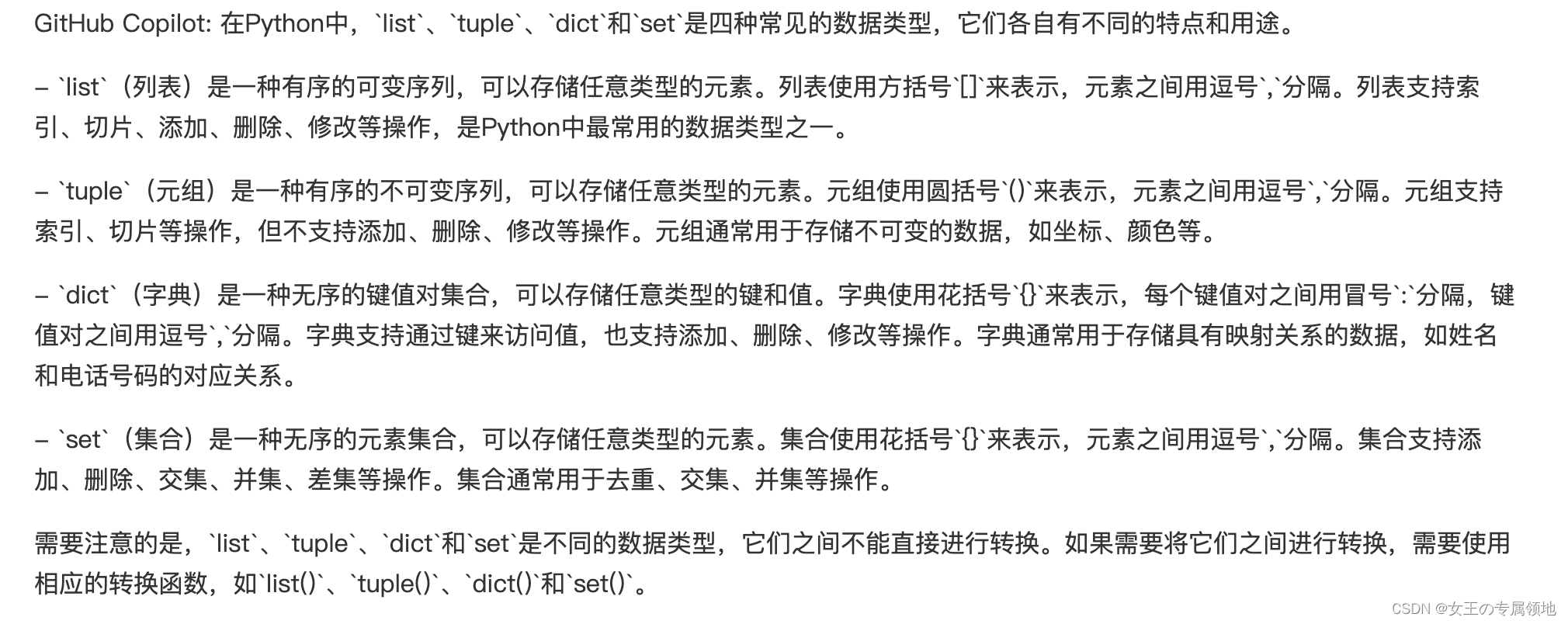第三周:Python能力复盘
发布时间:2023年12月18日
资料:
《笨办法学Python》阅读地址:https://www.bookstack.cn/read/LearnPython3TheHardWay《廖雪峰Python教程》阅读地址:http://t.cn/RK0qGu7
《机器学习numpy与pandas基础》:https://zhuanlan.zhihu.com/p/639733816
《matplotlib绘图可视化知识点整理》阅读地址:http://t.cn/RqDxDo8
工具anaconda:http://t.cn/RW92Dcn
爬虫:
《 1.1 requests库的安装与使用》阅读地址:http://t.cn/RTuUuf7
《1.2 BS4库的安装与使用》阅读地址:http://t.cn/RTu4PLz
《1.5 爬虫实践: 获取百度贴吧内容》阅读地址:http://t.cn/RTu4ZbV
《1.7 爬虫实践: 排行榜小说批量下载》阅读地址:http://t.cn/RTu4UHw
《1.8 爬虫实践: 电影排行榜和图片批量下载》阅读地址:http://t.cn/RTu45gz
基础功能
- 数据类型和变量:整数、浮点数、字符串、转义字符(\、\n、\t…)、布尔值(and、or、not…)、空值(NULL)、变量、常量;
- 字符串和编码:字符串(ASCII、Unicode、UTF-8…)、格式化(%d、%f、%s、%x…)、format(‘Hello, {0}, 成绩提升了 {1:.1f}%’.format(‘小明’, 17.125))、f-string(f“my number is{num:.2f}”)
- 列表lists:c1 = [‘Michael’, 1, A],值c1[2],追加append(“be”),insert(1,B),删除pop(3),修改c1[2] = 23,多维c2 = [‘s1’,1,D,[2,“like”]]
- 元组tuple:定义后不可改变,即不可增加、插入、修改,tuples = (1,2,3,[“he”,4])
,tuples[3][1] 输出4 - 条件判断:if … elif … else …,注意点①冒号;②从上往下判断,满足即跳出;
height = 1.75
weight = 80.5
BMI = weight/height*height
print(BMI)
if BMI<18.5:
print("too light")
elif 18.5< BMI <20:
print("正常")
else:
print("OK")
- 模式匹配:
score = 'B'
match score:
case 'A':
print('score is A.')
case 'B':
print('score is B.')
case 'C':
print('score is C.')
case _: # _表示匹配到其他任何情况,类似于 C 和 Java 中的default:
print('score is 其他.')
- 循环:for x in… 、while循环、break跳出循环、while跳出当前循环
name = ["zxx","djw","zy"]
for x in name:
print(x)
if x=="djw":
break #跳出循环
number = 10
while number<100:
print("too small")
number = number+1
if number%2==0:
continue #跳出当前循环
print(number)
- dict和set: dict字典(key:value):x in…查看字典中是否存在x、pop删除; set集合(key):add(key)、remove(key),无序无重复元素;

进阶功能
- 函数:https://docs.python.org/3/library/functions.html
- 定义函数:def 函数名(参数):函数体,函数值用return 返回
- 函数参数:在Python中定义函数,可以用必选参数、默认参数、可变参数、关键字参数和命名关键字参数,这5种参数都可以组合使用。但是请注意,参数定义的顺序必须是:必选参数、默认参数、可变参数、命名关键字参数和关键字参数。
# a,b是必选参数,c是默认参数
# *args是可变参数,args接收的是一个tuple;
# **kw是关键字参数,kw接收的是一个dict。
# 命名关键字参数需要一个特殊分隔符*,*后面的参数被视为命名关键字参数。
def f1(a, b, c=0, *args, **kw):
print('a =', a, 'b =', b, 'c =', c, 'args =', args, 'kw =', kw)
>>> f1(1, 2)
a = 1 b = 2 c = 0 args = () kw = {}
>>> f1(1, 2, c=3)
a = 1 b = 2 c = 3 args = () kw = {}
>>> f1(1, 2, 3, 'a', 'b')
a = 1 b = 2 c = 3 args = ('a', 'b') kw = {}
>>> f1(1, 2, 3, 'a', 'b', x=99)
a = 1 b = 2 c = 3 args = ('a', 'b') kw = {'x': 99}
def f2(a, b, c=0, *, d, **kw):
print('a =', a, 'b =', b, 'c =', c, 'd =', d, 'kw =', kw)
>>> f2(1, 2, d=99, ext=None)
a = 1 b = 2 c = 0 d = 99 kw = {'ext': None}
- 递归函数:在函数内部,可以调用其他函数。如果一个函数在内部调用自身本身,这个函数就是递归函数。
面向对象编程
通信与爬虫
Python数据分析
关注市场动态
文章来源:https://blog.csdn.net/Julialove102123/article/details/135073588
本文来自互联网用户投稿,该文观点仅代表作者本人,不代表本站立场。本站仅提供信息存储空间服务,不拥有所有权,不承担相关法律责任。 如若内容造成侵权/违法违规/事实不符,请联系我的编程经验分享网邮箱:chenni525@qq.com进行投诉反馈,一经查实,立即删除!
本文来自互联网用户投稿,该文观点仅代表作者本人,不代表本站立场。本站仅提供信息存储空间服务,不拥有所有权,不承担相关法律责任。 如若内容造成侵权/违法违规/事实不符,请联系我的编程经验分享网邮箱:chenni525@qq.com进行投诉反馈,一经查实,立即删除!
最新文章
- Python教程
- 深入理解 MySQL 中的 HAVING 关键字和聚合函数
- Qt之QChar编码(1)
- MyBatis入门基础篇
- 用Python脚本实现FFmpeg批量转换
- Python使用selenium自动爬取苏宁易购商品数据
- 羊大师讲解喝羊奶的好处多,降低脂肪风险还有不少!
- uniapp 用于开发H5项目展示饼图,使用ucharts 饼图示例
- Conda系列:【解决方案】Collecting package metadata (current_repodata.json): failed
- 常用网安渗透工具及命令(扫目录、解密爆破、漏洞信息搜索)
- 鸿蒙开发之简单登录页面
- 借助GPT理解 “ Android中 点击弹框外部 取消弹框”
- 未来十年不变的AI是什么?吴恩达等专家关于2024年AI发展趋势的预测
- Spring系列学习四、Spring数据访问
- Kubernetes实战(十五)-Pod垂直自动伸缩VPA实战